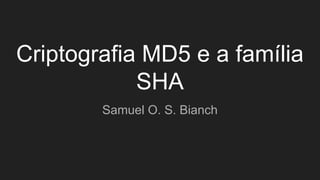
A Criptografia MD5 e a família SHA - Samuel O S Bianch
- 1. Criptografia MD5 e a família SHA Samuel O. S. Bianch
- 2. Agenda ● O que é criptografia ● Breve história ● Criptografia Hash ● MD5 ● Família SHA ● Conclusão
- 3. O que é criptografia ● A palavra criptografia vem do Grego Kryptós (escondido)e gráphein (escrita). ● É um ramo da matemática. ● É o estudo do princípios e técnicas que transformam informação em dados ilegíveis, de forma a dificultar e até mesmo impedir que outras pessoas tenham acesso a informação original.
- 4. O que é criptografia ● Ela funciona como se fosse um enigma. ● Possui sempre uma “palavra-chave”. ● Cifragem ● Decifragem
- 5. Breve história ● Primeiro registro no Egito (1900 a.c.); ● Livro da Bíblia de Jeremias (600 - 500 a.c.); ● Cifra de César (100 a.c.).
- 6. Breve história ● A máquina Enigma ● A máquina Eletromecânica de Turing; ● Algoritmo RSA.
- 7. Criptografia Hash ● Seja uma função hash H, e x uma string qualquer, teremos que H(x) será o valor hash para a string x. ● Algumas características básicas. — O valor de entrada da função possui qualquer tamanho; — O valor de saída da função possui tamanho fixo; — H(x) é relativamente fácil de ser computado, para qualquer valor de x; — H(x) é uma função “one-way”; — H(x) é livre de colisão.
- 9. MD5 ● Mais voltada para sistemas 32 bits; ● Algoritmo Hash de 128 bits one-way; ● 2^128 hashes possíveis; ● Sucessor do MD4; ● Verifica-se os dois hash.
- 10. MD5 ● Ele é muito rápido; ● Possui algumas falhas de segurança: ○ Vários conflitos; ○ Tabelas de resolução do Hash compartilhadas na internet (rainbow tables).
- 11. MD5 MD5("The quick brown fox jumps over the lazy dog") 9e107d9d372bb6826bd81d3542a419d6 MD5("The quick brown fox jumps over the lazy cog.”) 1055d3e698d289f2af8663725127bd4b
- 12. Família SHA Consiste na família de algoritmos de hash criptografados denominados de Secure Hash Algorithm, publicados pela National Institute of Standards and Technology (NIST). Fazem parte da família SHA: ● SHA-0; ● SHA-1; ● SHA-2; ● SHA-3.
- 13. SHA-0 ● Baseado no MD5; ● Uma colisão demorava cerca de 80.000 horas em um supercomputador; ● Logo foi ultrapassado.
- 14. SHA-1 Projetado pela Agência Nacional de Segurança (NSA) dos Estados Unidos é outro padrão publicado pela NIST. Produz um valor de dispersão de 160 bits (20 bytes). Foi muito usado na internet, mas hoje já não é mais aceito.
- 15. SHA-2 SHA-2 foi publicada em 2001 pelo NIST como um padrão federal dos Estados Unidos (FIPS). A família SHA-2 de algoritmos está patenteada sob uma licença livre de royalties. A família SHA-2 é composta por seis funções hash com resumos (valores de hash) que são de 224, 256, 384 ou 512 bits: SHA224, SHA-256, SHA-384, SHA-512, SHA-512/224, SHA512/256.
- 16. SHA-3 Proposto em uma competição feito pela NIST; Algoritmo Keccak; Diferente de todos os outros algoritmos, baseados no MD4, sempre exibindo características similares, como MD5, SHA0, SHA-1 e SHA-2, o SHA-3 é um formato que não deriva do SHA-2.
- 17. Conclusão ● É normal os algoritmos irem mudando e ficando mais complexos; ● Dificuldade de se entender os cálculos; ● MD5 ótimo para conferência de compartilhamento de mídias, mas não deve ser usado para autenticação. ● A Família SHA se mostra a alternativa mais confiável, com o SHA-2 e o SHA-3.